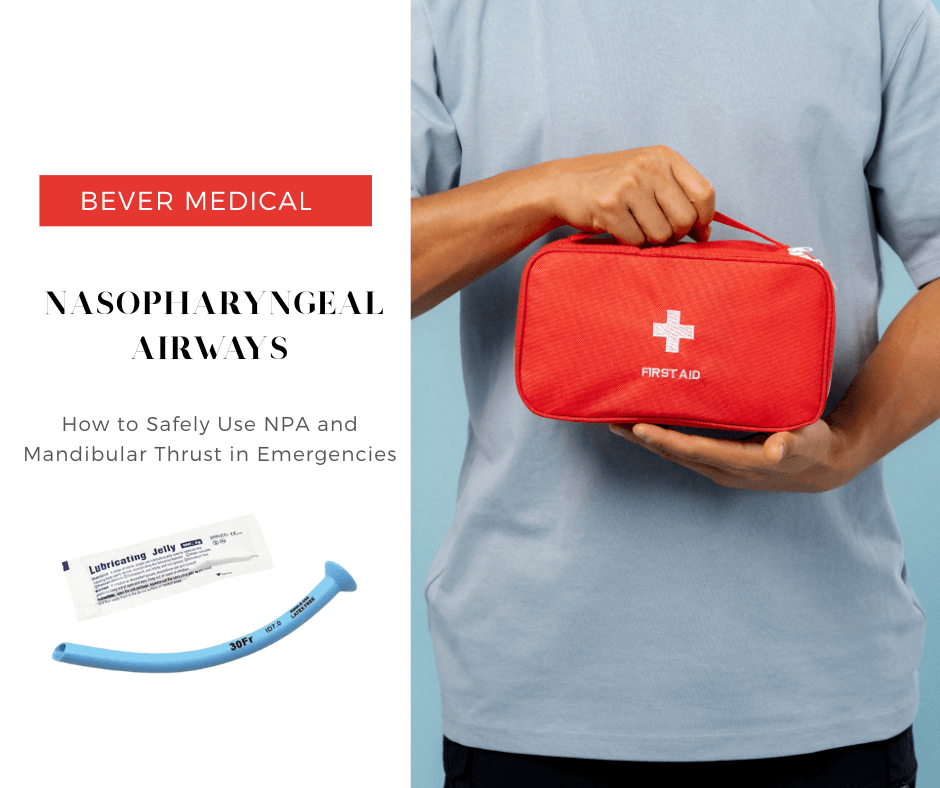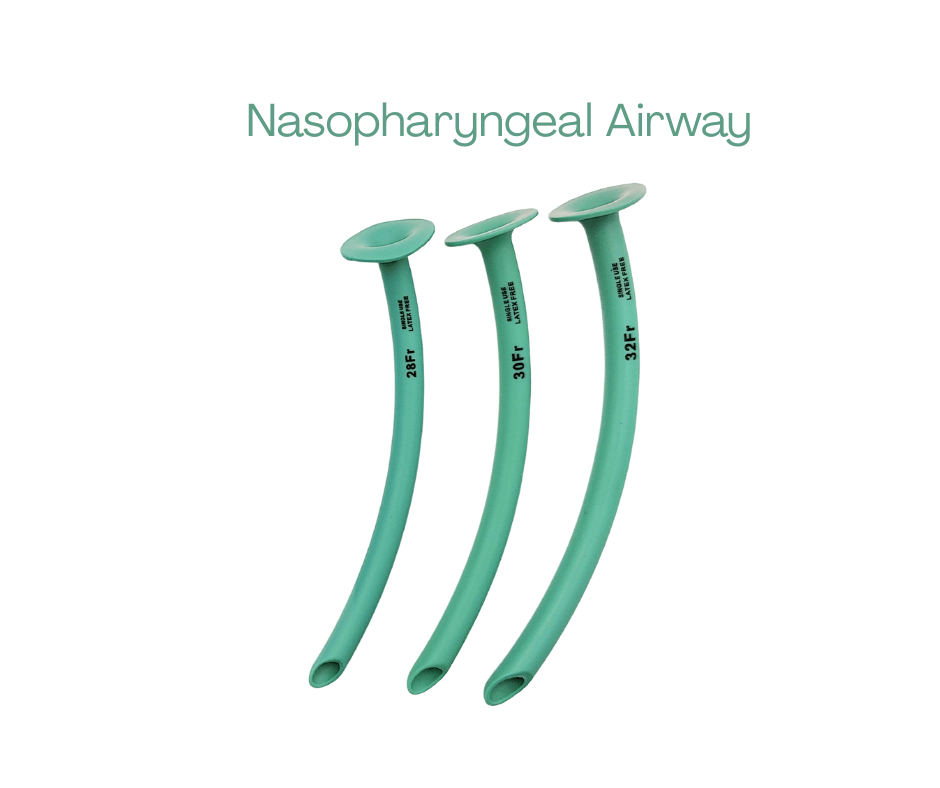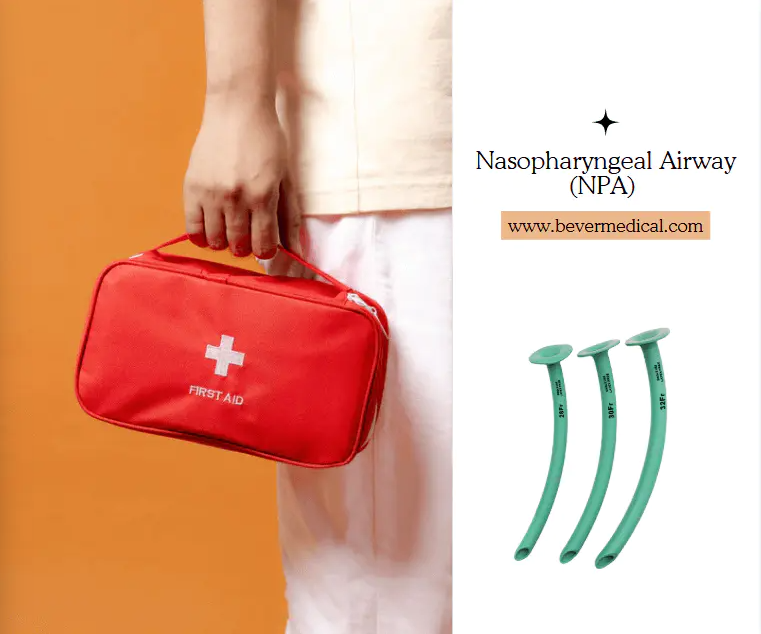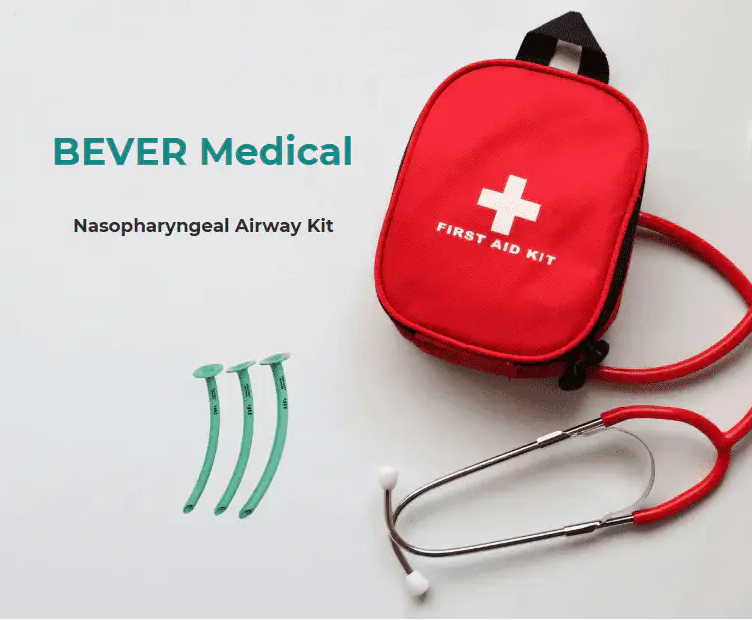When someone can't breathe—whether it's out in the field, during a rescue, or in the ER—you don't always have time to wait. A nasopharyngeal airway (NPA), sometimes named a nasopharyngeal trumpet, can keep the airway open fast. And if you can't get a tube in right away, the jaw thrust is a simple move that can save a life. This guide shows how to use both safely, with tips from real situations to help you get it right when it really counts. Nasopharyngeal Airway Selection and Insertion When someone can't breathe well but still has a gag reflex—or they just can't handle something in their mouth—an NPA (nasopharyngeal airway) can be a lifesaver. It's soft, flexible, and goes through the nose to keep the airway open without setting off the gag. Key Features from Bever Medical: Smooth, rounded tip that slides in easy Flared end with size marked right on it—no guessing Comes sterile, latex-free, and some packs include lube or a jelly packet Sizes from 14 to 38 French, one per pack, FDA and CE certified In the field, real-life situations show just how important a good NPA is. Take Sergeant-Medic Ramirez in Kandahar: she found a soldier with facial burns and a swollen tongue. The guy was barely conscious and struggling to breathe. Ramirez grabbed a 28 Fr NPA from her kit, tore open the jelly packet, lubed the tip, and slid it in—bevel side toward the septum. Within seconds, the soldier started breathing on his own. No gagging, no delay. Just quick action and the right tool. Studies show NPAs can really help. In one trial during sedation, the number of patients with low oxygen dropped from 13.5% to just 1.9%. And only 4.7% had minor nose injuries. How to Use It (Step-by-Step) Pick the right size—nostril to earlobe is a good guide Add lube if it's not pre-lubed Slide it in gently, bevel toward the septum Stop when the flange touches the nose Check for breath sounds and chest rise Don't Use If: There's major facial trauma You think there's a skull fracture at the base How to Combine Jaw Thrust and NPA for Faster Airway Access Corporal Singh's patient lost consciousness during transport over rough terrain. A rapid jaw thrust converted silent obstruction into audible ventilations, buying time until landing. Efficacy and Comparison Studies show the jaw thrust works just as well as head tilt in most cases—and it's safer if there's a neck injury. In sedated patients, modified jaw thrust improved upper airway patency at the tongue base in 82% of cases, albeit with occasional arousal in 10%. Integrating NPA and Jaw Thrust Using both together works even better. First, do a jaw thrust to open the airway. Then slide in the NPA to keep it open. This lets the patient keep breathing or helps with suction. Keep an eye on their breathing and oxygen. Tip: Instead of guessing the size, try this: do a quick jaw thrust and see how far the jaw moves forward. That can help you pick the right NPA length and avoid hurting soft tissue. Product Selection Tips for B2B Buyers Opt for sterile, individually packaged NPAs with rounded tips and clear ID markings. For rapid deployment, choose pre-lubricated kits (one NPA + jelly) sized 14 Fr–38 Fr. Ensure OEM flexibility for co-branding in IFAKs and compliance with FDA 510(k) and CE. Train staff with hands-on drills using both unlubricated and pre-lubricated NPAs alongside jaw thrust practice. Final Thoughts Mastering the safe use of the nasopharyngeal airway and mandibular thrust maneuver transforms airway management in emergencies. Equip your teams with a high-quality nasopharyngeal airway kit and rigorous training to ensure readiness in any environment. Want to make sure your team's ready? Check out BEVER Medical's full range of NPAs. We've got FDA-cleared options to help you save more lives.
View More +-
28 Jul 2025
When it comes to treating strokes or heart attacks with clot-busting therapy, every second counts. But in elderly patients, there's another critical factor that often goes overlooked: airway safety. Older patients are often frail, less responsive, and more prone to airway obstruction, especially when lying flat or under sedation. Vomiting, weakened gag reflex, or reduced muscle tone can all increase the risk of compromised breathing. And in emergency scenarios, even a minor delay in managing the airway can lead to catastrophic outcomes. This is where nasopharyngeal airways (NPAs) come into play. Simple, fast, and effective, NPAs help maintain a clear passage for oxygenation—without requiring aggressive intervention. For hospitals, EMS crews, and military medics operating under pressure, FDA- and CE-certified OEM NPAs from Bever Medical offer the quality, consistency, and reliability needed to protect the airway while the team focuses on saving lives. In this blog, we'll break down why airway risks are higher in elderly thrombolytic patients, how to identify early signs of obstruction, and how NPAs can help mitigate the danger—safely and efficiently. Airway Challenges in Elderly Thrombolysis Thrombolytic agents such as alteplase (rtPA) carry a 1–5% risk of orolingual angioedema in acute ischemic stroke patients. In the elderly—often on ACE inhibitors—the risk climbs toward the upper end, with swelling of lips, tongue, and oropharynx compromising patency within 30–150 minutes of infusion. A typical case: an 84-year-old woman on lisinopril developed severe tongue edema 30 minutes after rtPA, necessitating emergent intubation. A stroke itself impairs central control of breathing and cough reflexes. Cognitive decline and pre-existing neurological deficits heighten aspiration and obstruction risks during and after fibrinolysis. In one series, elderly stroke patients had threefold higher intubation rates when airway adjuncts were delayed. Anatomical Considerations for NPAs in the Elderly Nasal mucosa thins with age, and microvascular fragility increases the risk of bleeding, especially when patients are on anticoagulants or thrombolytic therapy. Conditions like septal deviation, turbinate hypertrophy, or past nasal trauma can further narrow the nasal passages. A well-designed nasal trumpet helps address these challenges: its rounded, beveled tip allows for atraumatic insertion, while the soft, tapering shaft conforms to nasal anatomy, minimizing pressure on sensitive mucosa. Size markings on the flange aid in selecting the correct size—especially important as nostril diameter can vary with age. Thrombolytics, Fragile Nasal Mucosa, and Bleeding Risk When we think about thrombolytic therapy, bleeding risks are often top of mind — especially in older patients. But one often overlooked area is the airway, particularly the nose. Thrombolytics don't just increase bleeding risks in obvious places like the GI tract or brain. They also raise the chances of small, persistent bleeds in more delicate areas — like the nasal mucosa. In elderly patients, the nasal lining tends to be thinner and more fragile. Combine that with age-related changes in blood vessels and the systemic effects of thrombolytics, and you've got a recipe for trouble. In fact, research shows that with each passing year, elderly patients face up to four times the bleeding risk during thrombolytic treatment. While major nosebleeds (epistaxis) are rare, even minor ones can block the nasal airway — which is a big deal if you're relying on a nasopharyngeal airway (NPA) to maintain ventilation. While NPAs can still be used when necessary, the choice and handling of the device becomes especially important in elderly patients to minimize complications. How NPAs Mitigate Hidden Risks Maintaining a patent airway despite angioedema onset. If tongue swelling precludes oropharyngeal adjuncts, the NPA preserves a channel. Avoiding intubation complications. In stroke patients, NPAs reduced intubation rates from 40.3% to 19.2% versus oropharyngeal devices (P < 0.05). Reducing pulmonary infections. Less invasive than repeated intubation, NPAs cut post-stroke pneumonia from 24.7% to 14.1% (P < 0.05). Innovative NPA Features from Bever Medical Bever's OEM-manufactured nasopharyngeal airways combine: Rounded, beveled tip for painless insertion Secure, round flange to prevent migration ID-marked flange for rapid size verification Sterile, disposable packaging—ideal for pre-packed military and EMS kits Latex-free composition to eliminate allergy risks Practical Tips for Procurement and Use Choose FDA and CE-certified NPAs in a range of sizes (6 mm–9 mm ID). Train staff on atraumatic lubrication and gentle insertion at a 70° angle following the nasal floor. Store individually packaged NPAs in airway kits for rapid deployment in stroke codes or battlefield triage. Integrate NPAs into thrombolysis protocols with immediate readiness to counter orolingual angioedema. Conclusion Elderly patients on thrombolytic therapy harbor concealed airway hazards—angioedema, aspiration, and mucosal bleeding—that demand proactive solutions. A high-quality nasopharyngeal airway from Bever Medical can be the difference between a stable airway and an emergency cricothyrotomy. Moreover, we also supply military-grade nasopharyngeal airways. Contact us today to customize NPA products for your hospital or EMS. This article is for reference only. Please follow the guidance of qualified healthcare professionals.
View More + -
18 Jul 2025
When it comes to tactical airway management, the simple yet effective nasal trumpet—officially known as a nasopharyngeal airway (NPA)—is a go-to device for army medics and field responders. But not all NPAs are fit for mission-critical environments. Here’s how to evaluate and choose the best military-grade NPA, ideal for army use: 1. Material: Soft, Latex‑Free PVC or Silicone Look for medical-grade PVC or silicone—materials known for flexibility and patient comfort during insertion through the nasal passage Always opt for latex-free NPAs to avoid allergic reactions, especially in prolonged field deployments . 2. Beveled Tip for Atraumatic Insertion A beveled, rounded distal tip is non-negotiable. It ensures smooth, atraumatic insertion even under stress. This feature is crucial to prevent mucosal injury during fast-paced military first aid. 3. Flared (Trumpet‑Style) End to Prevent Migration A flared or trumpet-shaped flange reliably prevents the airway from slipping into the nasal passage. It also enables quick visual or tactile confirmation of placement—critical when medics are on the move. 4. Individual Sterile Packaging & Pre‑Lubrication Choose NPAs that come in sealed, single-use sterile pouches, perfect for Individual First Aid Kits (IFAKs) and field med packs. Pre-lubricated NPAs (e.g., 28 Fr with water-soluble gel) cut preparation time and ease insertion in high-stress scenarios. 5. Adjustable, CE/FDA Certified & OEM‑Ready Adjustable depth-disc models allow medics to standardize insertion to the ear-lobe marker—ideal for multi-user army environments. Ensure CE and FDA 510(k) approval for regulatory compliance across international military procurement. OEM flexibility (brand labeling, kit integration, size variety 14–38Fr) supports both government contracts and private tactical gear lines. Quick Feature Matrix – Mission-Ready Checklist Conclusion Whether stocking an IFAK or assembling a combat medic pack, the right nasopharyngeal airway can be the difference between a blocked airway and a lifesaving intervention. Choose NPAs designed with the mission in mind—comfortable, secure, and ready for action under pressure. BEVER Medical offers high-quality, field-tested NPAs tailored for military, emergency, and tactical use. Explore specs and OEM options at bevermedical.com.
View More + -
09 Jul 2025
A nasopharyngeal airway (NPA) provides a less invasive alternative to endotracheal intubation. It is commonly used in emergencies to maintain a patient's airway patency, particularly in managing unconscious patients with intact gag reflexes. However, the NPA insertion operation looks easy; it may cause catastrophic risks. The most serious potential complication is intracranial placement through the cribriform plate of the ethmoid bone, which can result in direct brain injury, cerebrospinal fluid leakage, and even death. Reading now to learn how to minimize risks. Potential Complications of NPA Insertion Before the most severe complication, it's important to get to know the range of potential adverse events that can occur during NPA insertion. Common but Relatively Minor Complications Nasal mucosal trauma and epistaxis represent the most frequent complications. The nasal cavity's rich vascular supply makes bleeding almost inevitable during insertion, though this is usually minor and self-limiting. Healthcare providers should be prepared to manage nosebleeds and monitor for aspiration risk, especially when using nasal trumpets in prehospital or emergency care settings. Pressure necrosis of nasal tissues can develop with prolonged placement. Extended use of improperly sized NPAs may cause compression injury to the nasal alae or nasal septum, leading to tissue breakdown and ulceration. This complication emphasizes the importance of proper sizing and regular assessment. Inadvertent placement into the wrong anatomical spaces occurs when the NPA is inserted too deeply or at incorrect angles. The device may enter the soft tissues of the nasopharynx rather than following the intended pathway, potentially causing local trauma and reducing effectiveness. Gag reflex stimulation and aspiration can occur if the NPA is too long or stimulates the posterior pharynx. This may trigger vomiting, laryngospasm, or aspiration pneumonia, particularly in patients with diminished protective reflexes. Read: Complications of a nasopharyngeal airway too long (blog) The Most Serious Complication: Intracranial Placement Anatomical Basis and Mechanism The cribriform plate of the ethmoid bone forms a thin, perforated barrier between the nasal cavity and the anterior cranial fossa. This sieve-like structure, naturally weakened by multiple foramina for olfactory nerve passage, represents the most vulnerable point for NPA misplacement. When basilar skull fractures or congenital anomalies compromise this structure, the risk of intracranial penetration increases dramatically. Intracranial placement occurs when the NPA accidentally penetrates the cribriform plate and enters the cranial vault. This catastrophic event typically results from several factors: forceful insertion, incorrect insertion angle (directed cephalad rather than posteriorly), or insertion in patients with unrecognized basilar skull fractures. These risks are especially relevant for field applications involving the nasopharyngeal airway army, where rapid airway access is often critical, but anatomical assessment may be limited. Devastating Consequences The consequences of intracranial NPA placement are severe and potentially fatal: Direct brain tissue injury occurs when the NPA tip penetrates the cerebral cortex, causing immediate neurological damage. This mechanical injury destroys brain tissue and can result in permanent neurological deficits or death. Cerebrospinal fluid leak develops when the dura mater is breached, leading to CSF rhinorrhea. This creates a direct communication between the sterile intracranial space and the contaminated nasal cavity, significantly increasing infection risk. Intracranial hemorrhage may result from vascular injury during NPA insertion. Blood accumulation within the confined cranial space can cause dangerous increases in intracranial pressure, leading to brain herniation and death. Meningitis and brain abscesses represent serious infectious complications. The breach in normal anatomical barriers allows bacterial invasion of the central nervous system, potentially causing life-threatening infections. Risk Factors and Prevention High-Risk Patient Populations Patients with basilar skull fractures represent the highest risk group. Clinical signs include Battle's sign (mastoid bruising), raccoon eyes (periorbital ecchymosis), CSF otorrhea or rhinorrhea, and hemotympanum. These findings indicate potential cribriform plate disruption and absolute contraindication to NPA use. Pediatric patients face increased risk due to thinner, more fragile skull structures. The cribriform plate in children is particularly vulnerable to injury, making careful assessment essential before NPA insertion. Patients with facial trauma or suspected midface fractures require careful evaluation. Severe craniofacial injuries may involve basilar skull fractures that are not immediately apparent, increasing the risk of intracranial placement. Prevention Strategies Healthcare providers must carefully evaluate for signs of basilar skull fracture, including neurological examination and assessment of facial trauma patterns. When in doubt, alternative airway management techniques should be employed. Proper insertion technique significantly reduces complication risk. The NPA should be well-lubricated and inserted gently along the nasal floor, directed posteriorly toward the occiput rather than the cephalad. Comprehensive Guide on How to Insert NPA? Providers should never force insertion against resistance. Appropriate sizing ensures safe placement. The NPA should be measured from the nostril to the earlobe, with the internal diameter corresponding to the patient's nostril size without causing blanching of nasal tissues. Use of quality devices with proper design features enhances safety. Modern NPAs should feature rounded, beveled tips for atraumatic insertion, secure flanges to prevent over-insertion, and size markings for proper selection. Devices should be latex-free, sterile, and individually packaged. Management of Suspected Intracranial Placement When intracranial placement is suspected, immediate action is required to prevent further injury and complications. Cessation of insertion and careful stabilization of the NPA in its current position prevents additional trauma. The device should not be advanced further or removed without neurosurgical consultation, as removal may cause additional injury or worsen hemorrhage. Immediate imaging with CT scanning confirms the NPA position and assesses for associated injuries. Imaging helps determine the extent of intracranial penetration and guides treatment decisions. Urgent neurosurgical consultation is mandatory. Neurosurgeons must evaluate the need for surgical removal, management of CSF leaks, and treatment of any associated brain injuries. The complexity of these cases requires specialist expertise. Supportive care includes monitoring for neurological changes, managing increased intracranial pressure, and preventing secondary complications. Patients require intensive monitoring in appropriate care settings. Conclusion While the nasopharyngeal airway is an essential device in emergency airway management, the most serious potential complication, intracranial placement, can result in permanent neurological injury or death. Though rare, it must always be considered. Healthcare providers must maintain a heightened awareness of this complication, particularly when managing patients with facial trauma or suspected basilar skull fractures. Need high-quality nasopharyngeal airways for military, EMS, or OEM medical supplies? Bever Medical offers precision-designed, FDA and CE-certified NPAs. Explore now and ensure your organization is equipped for safe airway management in every scenario.
View More + -
05 Jul 2025
In remote locations where medical support is miles—or hours—away, having the right tools can mean the difference between life and death. A nasopharyngeal airway kit is one of the most essential components in any well-stocked wilderness or tactical first aid pack. Designed to maintain an open airway in unconscious or semi-conscious patients, this simple yet effective device is a cornerstone of emergency airway management—especially when jaw trauma, clenched teeth, or limited access makes oral airways unfeasible. But knowing how to use it is only half the equation. Choosing the right material and size for your nasopharyngeal airway (NPA) is just as critical. In this guide, we explore why the NPA kit is indispensable in field conditions and how to select the most suitable type for your needs. Why Use a Nasopharyngeal Airway Kit in Field Emergencies? When someone becomes unconscious—due to trauma, heat exhaustion, low oxygen, seizure, or cardiac arrest—their tongue may relax and block the airway. In such situations, quick insertion of an NPA can: Prevent airway obstruction Support spontaneous breathing Buy time until advanced help arrives Avoid unnecessary intubation attempts In outdoor settings where dust, dirt, and debris can complicate airway access, NPAs are favored for their ease of insertion and minimal need for head positioning. They are particularly valuable in environments where cervical spine injury is suspected, and head-tilt maneuvers must be avoided. What's in a Nasopharyngeal Airway Kit? A standard field-ready NPA kit typically includes: A soft, pre-lubricated or lubricated nasopharyngeal airway tube Sterile, water-soluble lubricant Optional: gloves and alcohol wipes Compact, sterile packaging that fits easily in an IFAK or field pouch Many kits come pre-lubricated or include a lubricant sachet, ensuring smooth insertion even under high-stress conditions. Choosing the Right Material: PVC vs. Silicone vs. Latex-Free There is no one-size-fits-all NPA, especially when considering comfort, flexibility, and environmental adaptability. Here's how to decide: PVC (Polyvinyl Chloride) Pros: Cost-effective, slightly firm for easier insertion Best for: Single-use, rugged environments where durability matters Caution: May become stiff in cold weather; check if latex-free if needed Silicone Pros: Ultra-soft, biocompatible, maintains flexibility in cold temperatures Best for: Reusable settings, sensitive patients, cold weather or altitude use Caution: Typically more expensive Latex-Free NPAs Pros: Safe for patients with latex allergies, compliant with hospital and military standards Best for: Broad use without allergy risk Caution: Check materials if not explicitly marked as latex-free For field kits used in cold climates or tactical operations, silicone NPAs offer better flexibility and reduced patient discomfort. For mass-distribution or civilian IFAKs, PVC versions are a practical and economical choice. Choosing the Right Size Selecting the correct NPA size is essential for both efficacy and safety. Improper sizing may lead to inadequate ventilation or nasal trauma. Sizing by Diameter Most NPAs are sized using internal diameter (ID) in millimeters, typically ranging from 6.0mm to 9.0mm for adults. 6.0mm – 6.5mm: Small adults or females 7.0mm – 7.5mm: Average adult males 8.0mm – 9.0mm: Larger adult males or tactical use Sizing by Length The tip should reach just above the epiglottis. A quick field method: Measure from nostril to earlobe. This gives a rough idea of appropriate length. Tip: Always carry multiple sizes in your kit. One size does not fit all, especially in variable environments. Field Application Tips Apply lubricant generously unless pre-lubricated Insert the NPA with the bevel toward the nasal septum If resistance is met, try the other nostril Never force the airway—if blocked, reassess or use an oral alternative For untrained users, the NPA is easier and safer to use than oral airways or supraglottic devices. That's why it's favored in military, outdoor rescue, and pre-hospital care scenarios. Final Thoughts: A Must-Have for Every Field Medic or Adventurer Whether you're a wilderness medic, military responder, search-and-rescue volunteer, or just an outdoor enthusiast preparing for emergencies, a nasopharyngeal airway kit is a lightweight yet lifesaving investment. Easy to use Effective in trauma and unconsciousnessSmall enough for every first aid pouch Need High-Quality NPA Kits in Bulk? We offer OEM services, military-grade packaging, and international shipping with CE, FDA, and ISO13485 certifications. Contact us today to request free samples or bulk pricing tailored to your region and field requirements.
View More + -
25 Jun 2025
When it comes to airway management, the nasopharyngeal airway (NPA) is a simple yet lifesaving device. Used in both emergency and clinical settings, NPAs help maintain an open airway in semi-conscious or unconscious patients. While sizing and technique are essential, the material of the NPA can significantly impact patient safety, comfort, and overall usability. In the medical device market, NPAs are typically made from PVC (polyvinyl chloride), silicone, or latex-free compounds. Each material has its strengths and limitations. Understanding the differences is key for clinicians, purchasing managers, and distributors aiming to match product performance with patient needs and institutional goals. PVC NPAs PVC (polyvinyl chloride) is the most widely used material for disposable NPAs and many other medical products. Known for its versatility and low cost, PVC has become a go-to choice for high-volume hospital settings and emergency response kits. Key Features: Affordable and easy to mass-produce Firm enough for smooth insertion Available in multiple sizes Pros: Cost-effective: Ideal for bulk procurement and single-use applications Readily available: Compatible with most prehospital and hospital supply chains Reliable performance: Stiff but flexible when warmed or lubricated Cons: Can become rigid in cold environments, increasing patient discomfort or injury risk Not inherently latex-free — always verify if labeled “latex-free” to avoid allergy issues Best for: EMS kits, military medical supplies Budget-sensitive facilities Disposable product use where patient interaction is brief Silicone NPAs Silicone NPAs are considered a premium option due to their high biocompatibility and soft, flexible structure. They are often used in settings where patient comfort is a top priority, including pediatric and geriatric care or when multiple airway insertions may be needed. Key Features: Inherently hypoallergenic Very soft and flexible, even in cold temperatures Can be sterilized or reused in select settings Pros: Superior patient comfort: Reduces risk of mucosal injury or discomfort Excellent for long-term or conscious use: Less likely to cause gag reflex Flexible in all environments: Ideal for transport or variable-temperature settings Cons: Higher cost: May not be feasible for single-use, high-volume settings Can be slippery to handle: Requires careful insertion and handling when lubricated Best for: Pediatric, elderly, or conscious patients Hospitals focused on comfort and care quality Facilities able to accommodate higher per-unit cost Latex-Free NPAs “Latex-free” refers to a product’s absence of natural rubber latex, a known allergen that can trigger severe reactions in sensitive patients and healthcare workers. Latex-free NPAs may be made from PVC, silicone, or thermoplastic elastomers (TPE). Key Features: Allergy-safe for patients and staff Increasingly required by regulatory standards Can be made from various materials Pros: Essential for modern healthcare settings: Helps meet hospital safety policies Widely accepted internationally: Compliant with CE, FDA, and ISO regulations Flexible base options: Can still benefit from PVC or silicone properties, depending on product Cons: Performance varies by base material: “Latex-free” is a safety label, not a performance indicator May be more expensive than non-certified alternatives Best for: General hospital use Pediatric and allergy-prone patients International buyers with latex-free compliance needs Quick Comparison Table Feature PVC Silicone Latex-Free (Varies) Cost Low High Varies Flexibility Medium High Depends on material Patient Comfort Moderate (with lube) Excellent Varies Allergy Risk Check label Very Low None Best Use Emergency, EMS Comfort care, ICU Hospitals, Export Conclusion Choosing the right NPA material is about more than price—it's about matching patient needs with the right product features. PVC offers excellent value for one-time use in high-volume or emergency scenarios. Silicone excels in sensitive patient groups and long-term care. Latex-free is no longer optional—it’s a minimum standard in most modern healthcare systems. Whether you are sourcing for a hospital, clinic, or EMS provider, always ensure material details are clearly stated on packaging and supported by quality certifications (e.g., CE, FDA, ISO 13485). Call to Action Looking for reliable, high-quality nasopharyngeal airways in PVC, silicone, or latex-free options?BEVER Medical offers a full range of NPAs in all adult and pediatric sizes, ready for OEM, bulk purchasing, and international delivery.Contact our sales team today to request product samples, specification sheets, or custom branding options.
View More +







